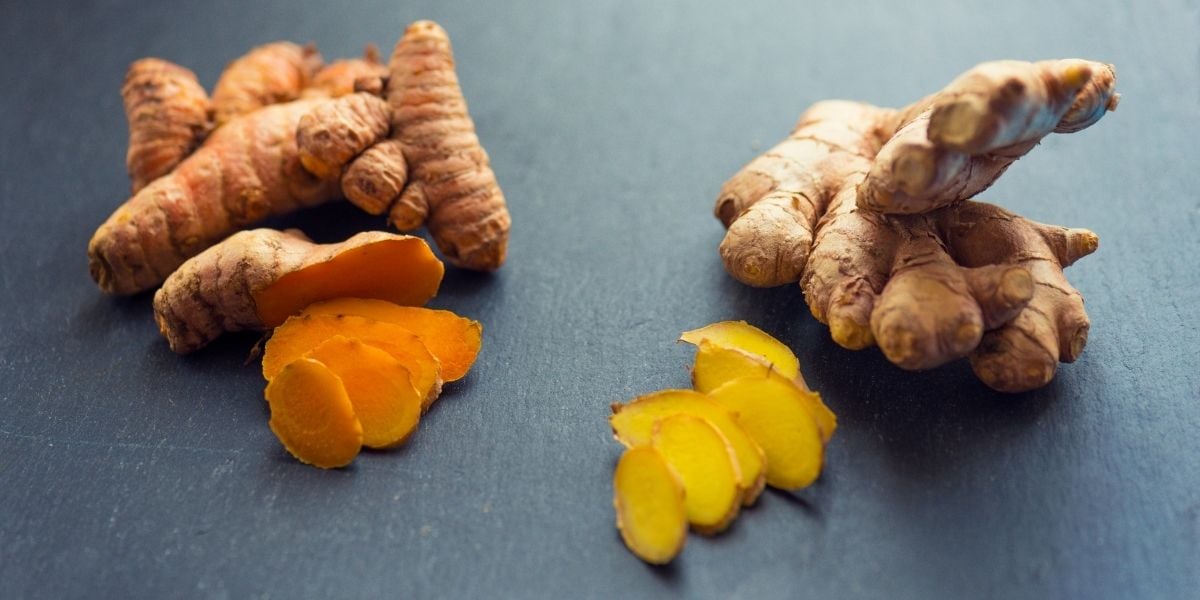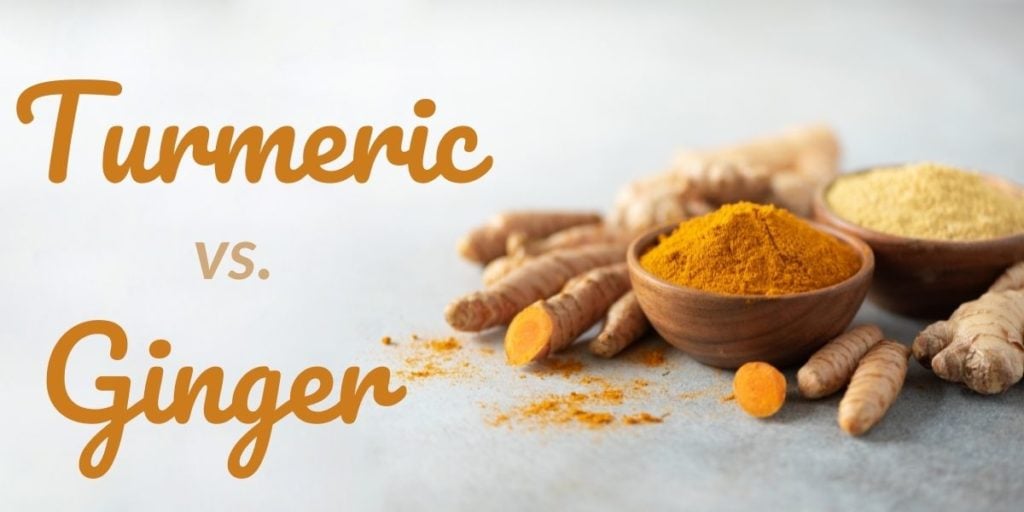This blog post on turmeric vs. ginger will cover these two spices’ similarities and differences. Is one of them better than the other? Do they have the same health benefits? How can you tell them apart? And so on… You’ve got questions, and we’ve got the answers for you. Scroll down to know more!
Table of Contents
Do turmeric and ginger rhizomes look alike?
No, they don’t, but it’s easy to see why some may think they look the same. The rhizomes of both turmeric and ginger look like bulbous, misshapen fingers with bumpy joints. Not surprising since both are members of the Zingiberaceae family of flowering plants. So, technically, they are “cousins”.
But there are noticeable differences when you see them in person. Turmeric’s outer skin is yellowish/orangey whilst ginger is a light brown. Slicing their rhizomes open reveals further differences in flesh color:
- turmeric is a bright orange (like a carrot), and
- ginger is yellow/beige (like a potato).
What are rhizomes exactly?
Rhizomes are the parts that grow underground and are commonly consumed as a spice. Often, they’re mistaken as roots, but they’re actually underground stems. Technically, they are “modified stems” since “stem” refers to their above-ground counterparts.
Turmeric vs ginger: Are they considered functional food?
By definition, functional foods offer health benefits besides their basic nutritional value (1). They serve a particular function, such as:
- enhancing the immune system
- promoting healthy digestion
- slowing down the ageing process
- helping the body recover from disease
- helping control physical and mental disorders
As you will see in the health benefits sections, both spices do qualify as functional foods!

Turmeric vs ginger health benefits: 5 surprising common benefits
So, before we dive into this section, let’s first describe what makes turmeric “turmeric” and what makes ginger “ginger”.
Well, for turmeric, it is the chemical Curcumin. And for ginger, it is Gingerol. Both contain other natural compounds, of course. But curcumin and gingerol are key to making both spices count as “functional food”.
Interestingly, both spices have similar health benefits, as you will see below!
1) Both are anti-inflammatory
Short-term inflammation is a healthy immune system response. But when it becomes long-term or chronic, it’s a bad thing. Depending on where the inflammation is, it can make you susceptible to many diseases. This includes diabetes, metabolic syndrome, hypertension, cardiovascular disease, arthritis, and more (2).
There are synthetic drugs that treat pain and inflammation. NSAIDs or non-steroidal anti-inflammatory drugs like ibuprofen and naproxen are examples. But long-term use of these drugs can lead to side effects (3).
Fortunately, a diet rich in ginger and turmeric can help ease inflammation. These two spices may work similarly to NSAIDs. Both are included in the list of plants with proven anti-inflammatory effects (4).
That said, when it comes to comparing ginger vs turmeric for inflammation, the latter may have an edge. A study done on arthritic rats showed they responded better to turmeric than either ginger or indomethacin (an NSAID) (5).
2) Antioxidant activity
Turmeric and ginger both have antioxidant properties. They help maintain our health at the molecular level by fighting off free radicals. If left unchallenged, these free radicals cause oxidative stress, leading to disease and rapid ageing. Take advantage of both spices’ antioxidant benefits by consuming more of them (7)!
3) Natural pain relievers
Both spices may help relieve abdominal pain, stomach discomfort, and other digestive disorders. Additionally, both may also help ease period-related pains in women. Here’s what some studies say:
- Ginger taken in 250mg capsules 4x daily was as effective as mefenamic acid and ibuprofen in relieving dysmenorrhea (8).
- Turmeric taken in 500mg capsules 2x daily also showed the same analgesic effect on women (9).
4) Anti-nausea a.k.a. antiemetic
Ginger is considered a natural antiemetic or anti-nausea remedy. It may help with motion sickness and pregnancy-related nausea. It’s even said to be more effective than Dramamine, an over-the-counter drug for nausea and motion sickness (10).
Turmeric is no slouch in this category either. It’s been used to treat vomiting patients since ancient times. It’s just that there aren’t nearly as many studies done on its antiemetic properties like ginger. So far, an animal study supports this thesis – curcumin improved the appetite of rats undergoing chemotherapy (11).
5) May help provide relief for cancer patients
Chemotherapy can kill cancer cells, but it also does a lot of damage to the body. Studies on both curcumin and ginger show that both may help slow down cancer progression. They can slow down and even stop cancer cells in their tracks (12, 13).
Using curcumin alongside chemo drugs has two benefits. It may help maximize the desired effects of the drugs. And it may also minimize any potential side effects (14).
As for ginger, its antiemetic effects may also provide much-needed relief to post-chemotherapy nausea (15).
Are curcumin and gingerol bioavailable?
Unfortunately, both curcumin and gingerol have issues with bioavailability (16, 17).
However, scientists continue to come up with creative ways to improve both compounds’ absorption rates. For instance, krill oil may help improve the absorption of ginger supplements (18).

For turmeric/curcumin, we believe Meriva’s nano-delivery technology is the best!
Studies done on Meriva Curcumin show that this form is 29x better absorbed than ordinary curcumin (19). This means you can take full advantage of curcumin’s health benefits, including the ones we’ve listed above.
For more information about our Intelligent Labs curcumin products, check out these links:
Meriva Curcumin Phytosome 250mg
Meriva Curcumin Phytosome 500mg
Turmeric vs ginger: Which one’s more flavorful?
Flavor-wise, let’s just say they are both extremely aromatic, especially when cooked in fresh, raw form.
Turmeric is characterized by a pungent, earthy, and bitter taste. On the other hand, ginger’s flavor profile is more on the peppery, sweet, and spicy side.
Both spices add lots of flavors to many different dishes around the world. Turmeric, in particular, takes it up a notch by also lending its bright yellow-orange hue to any dish it’s added to (curry, anyone?).
Oh, and another interesting fact that’s common between these two “cousins”? It’s not just the rhizomes that are edible. You can also eat/consume their leaves, stems, shoots, and even their flowers! And yes, all these other parts taste great, too!
Can you use turmeric as a substitute for ginger – and vice versa?
Well, if you’re in a pinch, you certainly can. They belong to the same plant family, after all. Just temper your expectations a bit as they’re not exactly a 1:1 substitution, more like an alternative spice to consider.
In addition to the difference in flavors, don’t forget to consider the dish’s appearance if swapping ginger for turmeric. Turmeric is a natural dye, so it will affect the color of your food. On the other hand, if using ginger in lieu of turmeric, you will lose all that lovely color. So, either way, something to keep in mind if swapping ingredients.
If you’re wondering if all turmeric powders are created equal? Well, check out the answer here in our blog post on the best turmeric powder.
Conclusion
Ideally, we should all be consuming turmeric and ginger regularly. But taking them in supplement form is a good alternative, too. Just make sure you speak with your doctor before taking turmeric or ginger as a supplement as their active compounds may interfere with medication.

